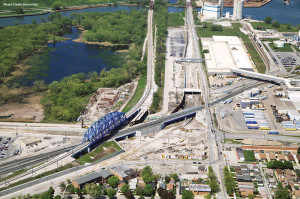An Accelerated Bridge Construction Feat
Alfred Benesch & Company was an Outstanding Award Winner for the 130th Street and Torrence Avenue Railroad Truss Bridge project in the 2013 NCSEA Annual Excellence in Structural Engineering awards program (Category – New Bridges & Transportation Structures).
On August 25, 2012, a multi-level grade separation designed by Alfred Benesch & Company (Benesch) made history when a 394-foot-long, 4.75-million pound, steel railroad truss bridge was rolled into place. Accelerated Bridge Construction (ABC) techniques were utilized to assemble and transport the truss 800 feet from a staging area to its final location in four hours. What is believed to be the largest, steel railroad truss bridge span ever rolled into place at the time of its construction now makes a striking silhouette as construction continues around it at the project site.
The new railroad truss replaced an existing Chicago, South Shore and South Bend (CSS&SB) Railroad bridge, which carries freight trains and the Northern Indiana Commuter Transportation District’s (NICTD) commuter rail line from South Bend, Indiana to downtown Chicago. Rolling in the new CSS&SB bridge was a key component of the 130th Street and Torrence Avenue intersection improvement project, an extremely complex, $101 million effort by the Chicago Department of Transportation (CDOT).
The intersection serves approximately 38,000 vehicles a day, including traffic to and from the nearby Ford Motor Company Plant. More than 50 freight trains also cross near the intersection, daily, on two at-grade Norfolk Southern Railway (NS) tracks while the CSS&SB tracks are supported over the existing NS tracks at Torrence Avenue. Realigning and depressing 130th Street and Torrence Avenue below the existing NS tracks will relieve traffic congestion and improve rail service efficiency in this area.
Construction of two new NS bridges were designed on offset alignments to minimize impacts to the railroad. The new alignments created a conflict with the existing elevated CSS&SB structure above. This conflict was resolved by replacing the existing CSS&SB bridge with a new structure on a new alignment. At the end of preliminary design, the proposed CSS&SB structure consisted of a 368-foot-long truss with abutments skewed at 45 degrees for the shortest span possible. However, geometric and logistical constraints surfaced during final design. The design team was challenged to explore options to minimize impacts to vehicular and rail traffic during construction, and reduce the construction schedule. This led the project team to investigate the use of ABC techniques. Eliminating the skew and building the truss span in a nearby staging area, then transporting the structure using Self-Propelled Modular Transporters (SPMTs), was found to be a more feasible and cost-efficient option. The revised structure consists of a truss that spans 394 feet center-to-center, with the bearings and supports perpendicular to the structure.
The project was advertised for bidding in September 2010. The contract was awarded to Walsh Construction Company (Walsh) who subcontracted with The Sarens Group to perform the roll-in. Benesch, in addition to being the designer for the preliminary and final design phases, also serves as the construction manager for the project. All teams involved were familiar with using SPMTs to roll in larger transportation structures.
In May 2012, truss assembly began in the staging area. By mid-August 2012, the truss was assembled and painted a signature blue. Before transferring the truss onto the SPMTs, the truss was jacked onto temporary supports. Two operators controlled the hydraulic jacks and were in constant communication to lift all four points of the truss the same amount simultaneously. After the SPMTs were positioned under the truss, it was ready to make its 800-foot journey from the staging area to its final location.
Walsh prepared a detailed schedule for the roll-in within the eight-hour window allowed by NS to interrupt train service, which was divided into 15 minute increments. Work also included dismantling the crossing gates and signals; laying a temporary crossing over the NS tracks for the SPMTs to traverse; and removing and reinstalling these items after the truss was moved into place.
On the Friday night before the move, Torrence Avenue was closed to traffic and the truss was moved 150 feet to the edge of the roadway to make sure the SPMTs were operating as planned. The truss was supported by four SPMT units, each consisting of 96 individually computer-controlled wheels capable of rotating 360 degrees. Combined, there were 384 wheels controlled by a single operator using a joystick, much like one used on a remote-controlled toy car. The SPMTs also lifted and lowered the truss, eliminating the need for cranes.
Closure of the NS tracks began Saturday morning. The truss moved 450 feet east. Then the SPMTs pivoted north and traveled another 200 feet where it stood inches above its final support location. It took two hours to move the truss into place and another two hours to adjust the location of the bearings. The SPMTs were removed, and track signals and crossings were restored well within the eight hour shutdown window.
Once the truss was in place, the contractor and railroad teams placed the ballast and ties on the truss, installed the catenary wires that power the NICTD trains and put the finishing touches on the truss. On October 25, 2012, the first NICTD train crossed the new truss bridge.
With the new CSS&SB railroad bridge in full working order, and construction continuing underneath, commuters are already taking advantage of the numerous benefits and travel efficiencies this project brings to the community. This work proceeded alongside the existing CSS&SB bridge, allowing rail service to remain operational. The success of the move was a huge win for Chicago, the community and for the project team.▪

